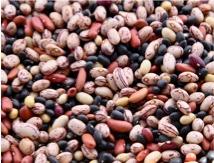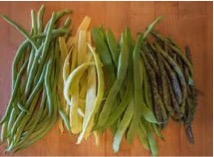Bean
-
Scientific NamePhaseolus vulgaris
-
General Information
 Photo: Courtesy UC Regents and Shelley Pauls, UnsplashAnnual, warm season legumes native to Central or South America. Grown since ancient times. Eat fresh in pod or shell and dry. Pole beans grow six to 10 feet. Bush beans grow two feet tall and wide. Good source of fiber and vegetable protein. Enriches soil with nitrogen.
Photo: Courtesy UC Regents and Shelley Pauls, UnsplashAnnual, warm season legumes native to Central or South America. Grown since ancient times. Eat fresh in pod or shell and dry. Pole beans grow six to 10 feet. Bush beans grow two feet tall and wide. Good source of fiber and vegetable protein. Enriches soil with nitrogen.
-
When to Plant
Plant snap and pole beans beginning in early May. Optimum temperatures for germination, growth and good yields are from 65 to 85 degrees.
Seeds planted in cold soils germinate slowly and are susceptible to rotting.
Lima beans require a soil temperature minimum 70 degrees.
Fava beans are a cool-season crop that can tolerate frost. They need about four to five months between planting and harvest. They can tolerate a minimum temperature of 40 degrees and a maximum temperature of 75 degrees.
-
Planting
Plant in full sunlight - at least four to six hours of sunlight a day.
Plant in full sunlight - at least six hours of sunlight a day.
Direct sow the bean seed and expect sprouting between seven to 14 days.
Beans need 70 to 80 days of moderate temperatures to be able to grow and harvest a good crop. Nights should not fall below 40 degrees and daytime temperatures should be between 70 and 90 degrees.
Bush beans: Sow seeds one inch deep and about three inches apart in rows 12-18 inches apart. They need room on either side for maximum production. Bush beans are usually harvested over a two to three week period of time and then die out. Successive plantings every two weeks will allow for a continuous harvest.
Pole beans: Sow seeds one inch deep and three inches apart at the base of poles or a trellis. Plant four to eight seeds around each pole, thinning to three plants per pole. Pole beans will continue to produce throughout the season.
-
Soil Requirements
Plant in a well-drained sandy loam that has been amended with compost or other organic materials. Beans prefer a soil pH level between 6.0 and 6.5. Soil must be kept evenly moist. Do not let the soil dry out.
-
Water Requirements
Consistent and adequate irrigation is required for good fruit set and yield. Too much or too little water causes blossom and pod drop. Beans tend to be shallow-rooted plants that are sensitive to over irrigation and soils that are low in oxygen.
-
Fertilizing
Beans do not require high amounts of nitrogen because they produce their own nitrogen. If the soil has been properly amended before planting the beans will not need additional nutrients. If a fertilizer is needed, use a vegetable fertilizer with more phosphorous and potassium than nitrogen.
-
Pollination
Self-pollinating.
-
Harvesting
Beans are usually ready for harvest 55 to 75 days after sowing. Harvest green beans when the pods are smooth and firm but before the seed in the pod has developed fully.
Bush beans are usually harvested over a two to three week period.
Pole beans are usually ready to harvest one to two weeks after flowering. Pole beans will continue to produce a crop throughout the growing season.
Harvesting beans for drying - leave the pod on the plant until both the pod and beans are dry. Pick the dried pods, remove the beans and bring inside to continue to dry.
-
Storage
Store unwashed fresh beans in a plastic bag or reusable container in the refrigerator vegetable bin. They should keep for about five to seven days.
Beans freeze well.
Dry beans should be stored in a food-safe container with a tight sealing lid in a cool, dry place away from sunlight.
-
Good Varieties for Marin
There are many bean varieties that grow well in Marin:
'Scarlet runner' 'Romano' 'Blue Lake' 'Kentucky Wonder' 'Yellow Pole Wax' 'Purple Peacocks' 'Nickel' 'Fava' 'Dragon Tongue' bush bean.
Explore heirloom and rare seed varieties for your garden. -
Helpful Tips
For best flavor and highest production, harvest daily.
At the end of the season, let a few beans dry on the plants and save the seeds for next year’s planting. Avoid saving seeds from plants grow in damp climates (where they are susceptible to disease) as the seeds may not be disease-free.
Know your microclimate. You may be able to grow a variety of different beans in your area.
Drip irrigation is the best method to insure leaves remain dry.
Young seedlings can be protected from pests with cloth or paper barriers until they have about six leaves.
-
Common Problems
A variety of viruses can attack beans.
Protect young bean plants from snails, slugs, flea beetles, vegetable weevils, leafminers, and birds.
-
Pests- Diseases & More
Learn more about growing beans.
Beans can get bacterial and fungal diseases if watered overhead, or if worked upon when the leaves are wet.


